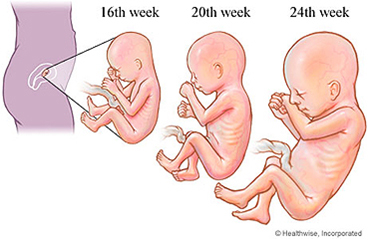Weeks 20 to 24 of Your Pregnancy

Your baby is continuing to develop quickly. It can now suck its thumb, grip firmly with its hand, and open and close its eyelids. You may also notice that your baby kicks and hiccups.
By now, fingernails and toenails have formed on your baby's hands and feet. Its skin is wrinkled, red, and shiny. And your doctor can easily hear its heartbeat with a regular stethoscope. At 24 weeks, your baby will be about 11 to 12 inches long and 1 to 1½ pounds.
During your second trimester, you may find that your nausea and fatigue are gone. Overall, you may feel better and have more energy than you did in your first trimester. But you may also have new discomforts now, such as sleep problems or leg cramps. This care sheet can help you ease these discomforts.
It is still generally safe for you to travel throughout your second trimester, but it is a good idea to take some precautions before you travel. This is also a time when you may start to wonder about going into labor early. Even though most babies are not born early, it is important to know the signs of preterm labor.
Some women begin to leak a yellowish or whitish fluid, called colostrum, from their breasts. This is the first breast milk, the kind you will have after birth, before your milk "comes in." If your clothes get wet from the leaking fluid, you can use all-cotton breast pads inside the cup of your bra.
Follow-up care is a key part of your treatment and safety. Be sure to make and go to all appointments, and call your doctor if you are having problems. It’s also a good idea to know your test results and keep a list of the medicines you take.
How can you care for yourself at home?
Ease sleep problems
- Avoid caffeine in drinks or chocolate late in the day.
- Get some exercise every day.
- Take a warm (not hot) shower or bath before bed.
- Have a light snack or glass of milk at bedtime.
- Do relaxation exercises in bed to calm your mind and body.
- Support your legs and back with extra pillows. Try a pillow between your legs if you sleep on your side.
- Do not use sleeping pills or alcohol. They could harm your baby.
Ease leg cramps
- Do not massage your calf during the cramp.
- Sit on a firm bed or chair. Straighten your leg, and bend your foot (flex your ankle) slowly upward, toward your knee. Bend your toes up and down.
- Stand on a cool, flat surface. Stretch your toes upward, and take small steps walking on your heels.
- Use a heating pad or hot water bottle to help with muscle ache.
Prevent leg cramps
- Cut back on lunch meats, packaged foods, and carbonated beverages.
- Be sure to get enough calcium. If you are worried that you are not getting enough, talk to your doctor.
- Exercise every day, and stretch your legs before bed.
- Take a warm bath before bed, and try leg warmers at night.
Travel safely
- Discuss your travel plans with your doctor. Ask him or her which countries are safest for pregnant women. Decide if you should take any health records with you.
- Take it easy if you travel to altitudes over 6,000 feet. Thinner air may make you feel sick or tired.
- On planes, get up frequently to get your blood flowing in your legs. In cars, stop every 2 hours to do this.
- Drink lots of clean water, and go to the bathroom often. In foreign countries, drink bottled water, and avoid uncooked vegetables and fruit that you cannot peel.
- Pace yourself. Rest when you get tired. Choose tour groups that let you take breaks.
Know the signs of preterm labor
- You have menstrual-like cramps, with or without nausea.
- You have about 4 or more contractions in 20 minutes, or about 8 or more within 1 hour, even after you have had a glass of water and are resting.
- You have a low, dull backache that does not go away when you change your position.
- You have pain or pressure in your pelvis that comes and goes in a pattern.
- You have intestinal cramping or flu-like symptoms, with or without diarrhea.
- You notice an increase or change in your vaginal discharge. Discharge may be heavy, mucus-like, watery, or streaked with blood.
- Your water breaks.
If you think you have preterm labor
- Go to the bathroom.
- Drink 2 or 3 glasses of water or juice.
- Lie down on your left side. Do not lie on your back.
- While lying on your side, find your breast bone. Put your fingers in the soft spot just below it. Move your fingers down toward your belly button to find the top of your uterus. Check to see if it is tight.
- Contractions can be weak or strong. Record your contractions for an hour. Time a contraction from the start of one contraction to the start of the next one.
- Single or several strong contractions without a pattern are called Braxton-Hicks contractions. They are practice contractions but not the start of labor. They often stop if you change what you are doing.
- Call your doctor if you have regular contractions. This means about 4 or more in 20 minutes, or about 8 or more within 1 hour, even after you have had a glass of water and are resting.

